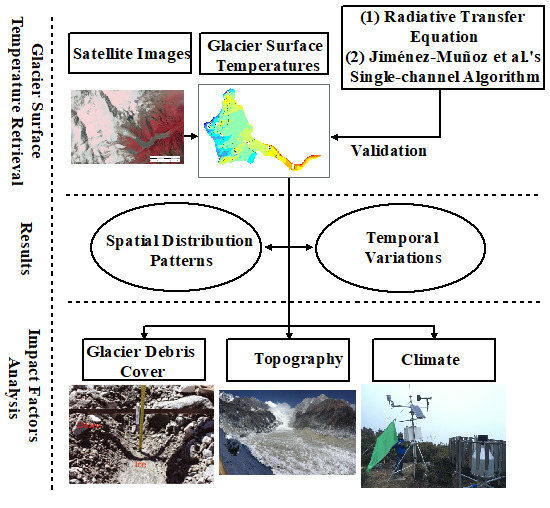Landsat-Based Estimation of the Glacier Surface Temperature of Hailuogou Glacier, Southeastern Tibetan Plateau, Between 1990 and 2018
Abstract
1. Introduction
2. Study Area
3. Materials and Methods
3.1. Satellite Images
3.2. GST Algorithms
3.2.1. The Mono-Window Algorithm
3.2.2. Calculation of the At-Sensor Brightness Temperature
3.2.3. Determination of Ground Emissivity
3.2.4. Estimation of Effective Mean Atmospheric Temperature
3.2.5. Estimation of Atmospheric Transmittance
3.3. Validation of GSTs
4. Results
4.1. Spatial Distribution Patterns of GSTs
4.2. Variations of GSTs between 1990–2018
5. Discussion
5.1. Errors in GST Remote Sensing
5.2. Impacts of Glacier Debris Cover Expansion and Ice Surface Darkening on GSTs
5.3. Effect of Topography on GSTs
5.4. Climate as a Major Factor in the Temporal Variation of GSTs
6. Conclusions
Author Contributions
Funding
Acknowledgments
Conflicts of Interest
Appendix A
| Date Acquired | Sensor Type | Path/ Row | Date Acquired | Sensor Type | Path/ Row | Date Acquired | Sensor Type | Path/ Row |
|---|---|---|---|---|---|---|---|---|
| 1990-05-05 | TM | 131/039 | 2000-08-20 | TM | 131/039 | 2009-11-26 | TM | 130/040 |
| 1990-07-08 | TM | 131/040 | 2000-11-24 | TM | 131/039 | 2010-01-20 | TM | 131/039 |
| 1990-12-24 | TM | 130/040 | 2000-12-26 | TM | 131/040 | 2010-03-18 | TM | 130/040 |
| 1991-04-15 | TM | 130/040 | 2001-05-03 | TM | 131/039 | 2010-08-09 | TM | 130/040 |
| 1991-07-20 | TM | 130/040 | 2001-06-13 | TM | 130/040 | 2010-10-12 | TM | 130/040 |
| 1991-09-29 | TM | 131/039 | 2001-11-27 | TM | 131/040 | 2011-01-07 | TM | 131/039 |
| 1992-01-03 | TM | 131/039 | 2002-01-14 | TM | 131/039 | 2011-04-29 | TM | 131/039 |
| 1992-05-03 | TM | 130/040 | 2002-10-13 | TM | 131/039 | 2011-08-12 | TM | 130/040 |
| 1992-08-07 | TM | 130/040 | 2003-02-18 | TM | 131/039 | 2011-10-06 | TM | 131/039 |
| 1992-11-18 | TM | 131/039 | 2003-04-16 | TM | 130/040 | 2013-04-18 | TIRS | 131/039 |
| 1993-01-30 | TM | 130/040 | 2003-07-21 | TM | 130/040 | 2013-07-07 | TIRS | 131/039 |
| 1993-04-27 | TM | 131/039 | 2003-09-23 | TM | 130/040 | 2013-10-11 | TIRS | 131/039 |
| 1993-07-09 | TM | 130/040 | 2004-02-14 | TM | 130/040 | 2013-12-30 | TIRS | 131/039 |
| 1993-12-07 | TM | 131/039 | 2004-04-25 | TM | 131/039 | 2014-04-14 | TIRS | 130/040 |
| 1994-04-30 | TM | 131/039 | 2004-06-12 | TM | 131/039 | 2014-07-26 | TIRS | 131/039 |
| 1994-06-26 | TM | 130/040 | 2004-11-28 | TM | 130/040 | 2014-11-08 | TIRS | 130/040 |
| 1994-09-05 | TM | 131/040 | 2005-01-06 | TM | 131/039 | 2015-02-03 | TIRS | 131/039 |
| 1994-12-26 | TM | 131/039 | 2005-04-05 | TM | 130/040 | 2015-05-10 | TIRS | 131/039 |
| 1995-04-10 | TM | 130/040 | 2005-09-19 | TM | 131/039 | 2015-07-06 | TIRS | 130/040 |
| 1995-08-07 | TM | 131/039 | 2006-02-26 | TM | 131/039 | 2015-10-26 | TIRS | 130/040 |
| 1995-10-10 | TM | 131/039 | 2006-05-17 | TM | 131/039 | 2016-01-05 | TIRS | 131/039 |
| 1996-02-15 | TM | 131/039 | 2006-08-30 | TM | 130/040 | 2016-03-18 | TIRS | 130/040 |
| 1996-03-02 | TM | 131/039 | 2006-11-18 | TM | 130/040 | 2016-08-16 | TIRS | 131/039 |
| 1996-10-12 | TM | 131/039 | 2006-12-27 | TM | 131/039 | 2016-11-04 | TIRS | 131/039 |
| 1997-06-25 | TM | 131/039 | 2007-04-18 | TM | 131/039 | 2017-01-07 | TIRS | 131/039 |
| 1998-04-09 | TM | 131/039 | 2007-06-14 | TM | 130/040 | 2017-03-28 | TIRS | 131/039 |
| 1998-07-30 | TM | 131/039 | 2007-09-18 | TM | 130/040 | 2017-07-11 | TIRS | 130/040 |
| 1998-09-16 | TM | 131/039 | 2008-04-04 | TM | 131/039 | 2017-10-06 | TIRS | 131/039 |
| 1999-01-22 | TM | 131/039 | 2008-07-18 | TM | 130/040 | 2017-12-09 | TIRS | 131/039 |
| 1999-03-04 | TM | 130/040 | 2008-10-13 | TM | 131/039 | 2018-04-09 | TIRS | 130/040 |
| 1999-11-06 | TM | 131/039 | 2009-02-18 | TM | 131/040 | 2018-08-31 | TIRS | 130/040 |
| 1999-12-17 | TM | 130/040 | 2009-04-16 | TM | 130/040 | 2018-11-10 | TIRS | 131/039 |
| 2000-05-09 | TM | 130/040 | 2009-06-03 | TM | 130/040 | 2019-02-07 | TIRS | 130/040 |
References
- Williamson, S.; Hik, D.; Gamon, J.; Kavanaugh, J.; Flowers, G. Estimating Temperature Fields from MODIS Land Surface Temperature and Air Temperature Observations in a Sub-Arctic Alpine Environment. Remote Sens. 2014, 6, 946–963. [Google Scholar] [CrossRef]
- Li, Z.L.; Tang, B.H.; Wu, H.; Ren, H.; Yan, G.; Wan, Z.; Trig, I.F.; Sobrino, J.A. Satellite-derived land surface temperature: Current status and perspectives. Remote Sens. Environ. 2013, 131, 14–37. [Google Scholar] [CrossRef]
- Kustas, W.; Anderson, M. Advances in thermal infrared remote sensing for land surface modeling. Agric. For. Meteorol. 2009, 149, 2071–2081. [Google Scholar] [CrossRef]
- Du, J.; He, Y.; Li, S.; Wang, S.; Niu, H.; Xin, H.; Pu, T. Mass balance and near-surface ice temperature structure of Baishui Glacier No.1 in Mt. Yulong. J. Geogr. Sci. 2013, 23, 668–678. [Google Scholar] [CrossRef]
- Xiao, H.; Weng, Q. The impact of land use and land cover changes on land surface temperature in a karst area of China. J. Environ. Manag. 2007, 85, 245–257. [Google Scholar] [CrossRef]
- Zhang, X.; Zhong, T.; Feng, X.; Wang, K. Estimation of the relationship between vegetation patches and urban land surface temperature with remote sensing. Int. J. Remote Sens. 2009, 30, 2105–2118. [Google Scholar] [CrossRef]
- Zaksek, K.; Oštir, K. Downscaling land surface temperature for urban heat island diurnal cycle analysis. Remote Sens. Environ. 2012, 117, 114–124. [Google Scholar] [CrossRef]
- Jansson, J.K.; Hofmockel, K.S. Soil microbiomes and climate change. Nat. Rev. Microbiol. 2019, 18, 35–46. [Google Scholar] [CrossRef] [PubMed]
- Albergel, C.; de Rosnay, P.; Gruhier, C.; Muñoz-Sabater, J.; Hasenauer, S.; Isaksen, L.; Kerr, Y.; Wagner, W. Evaluation of remotely sensed and modelled soil moisture products using global ground-based in situ observations. Remote Sens. Environ. 2012, 118, 215–226. [Google Scholar] [CrossRef]
- Nagornov, O.V.; Tyuflin, S.A.; Nikitaev, V.G.; Pronichev, A.N. Comparative analysis of the past glacier surface temperatures based on various probe-functions. J. Phys. Conf. Ser. 2017, 788, 012055. [Google Scholar] [CrossRef]
- Li, X.; Ding, Y.; Ye, B.; Han, T. Changes in physical features of Glacier No. 1 of the Tianshan Mountains in response to climate change. Chin. Sci. Bull. 2011, 56, 2820–2827. [Google Scholar] [CrossRef]
- He, Y.Q.; Li, Z.Q. Changes of the Hailuogou Glacier, Mt. Gongga, China, against the Background of Global Warming in the Last Several Decades. J. China Univ. Geosci. 2008, 19, 271–281. [Google Scholar]
- Mihalcea, C.; Brock, B.W.; Diolaiuti, G.; D’Agata, C.; Citterio, M.; Kirkbride, M.P.; Cutler, M.E.J.; Smiraglia, C. Using ASTER satellite and ground-based surface temperature measurements to derive supraglacial debris cover and thickness patterns on Miage Glacier (Mont Blanc Massif, Italy). Cold Reg. Sci. Technol. 2008, 52, 341–354. [Google Scholar] [CrossRef]
- Groos, A.R.; Mayer, C.; Smiraglia, C.; Diolaiuti, G.; Lambrecht, A. A First Attempt to Model Region-Wide Glacier Surface Mass Balances in the Karakoram: Findings and Future Challenges. Geogr. Fis. Din. Quat. 2017, 40, 137–159. [Google Scholar]
- Jiménez-Muñoz, J.C.; Sobrino, J.A. A generalized single-channel method for retrieving land surface temperature from remote sensing data. J. Geophys. Res. Atmos. 2003. [Google Scholar] [CrossRef]
- Wan, Z.M.; Dozier, J. A generalized split-window algorithm for retrieving land-surface temperature from space. IEEE Trans. Geosci. Remote Sens. 1996, 34, 892–905. [Google Scholar] [CrossRef]
- Wang, F.; Qin, Z.; Song, C.; Tu, L.; Karnieli, A.; Zhao, S. An Improved Mono-Window Algorithm for Land Surface Temperature Retrieval from Landsat 8 Thermal Infrared Sensor Data. Remote Sens. 2015, 7, 4268–4289. [Google Scholar] [CrossRef]
- Qin, Z.; Karnieli, A.; Berliner, P. A mono-window algorithm for retrieving land surface temperature from Landsat TM data and its application to the Israel-Egypt border region. Int. J. Remote Sens. 2010, 22, 3719–3746. [Google Scholar] [CrossRef]
- Cristóbal, J.; Jiménez-Muñoz, J.; Prakash, A.; Mattar, C.; Skoković, D.; Sobrino, J. An Improved Single-Channel Method to Retrieve Land Surface Temperature from the Landsat-8 Thermal Band. Remote Sens. 2018, 10, 431. [Google Scholar] [CrossRef]
- Sobrino, J.A.; Jiménez-Muñoz, J.C.; Paolini, L. Land surface temperature retrieval from LANDSAT TM 5. Remote Sens. Environ. 2004, 90, 434–440. [Google Scholar] [CrossRef]
- Wang, S.; He, L. Practical split-window algorithm for retrieving land surface temperature over agricultural areas from ASTER data. J. Appl. Remote Sens. 2014, 8, 083582. [Google Scholar] [CrossRef]
- Cahyono, A.B.; Saptarini, D.; Pribadi, C.B.; Armono, H.D. Estimation of Sea Surface Temperature (SST) Using Split Window Methods for Monitoring Industrial Activity in Coastal Area. Appl. Mech. Mater. 2017, 862, 90–95. [Google Scholar] [CrossRef]
- Anding, D.; Kauth, R. Estimation of sea surface temperature from space. Remote Sens. Environ. 1970, 1, 217–220. [Google Scholar] [CrossRef]
- Schneider, K.; Mauser, W. Processing and accuracy of Landsat Thematic Mapper data for lake surface temperature measurement. Int. J. Remote Sens. 2007, 17, 2027–2041. [Google Scholar] [CrossRef]
- Stroeve, J.; Steffen, K. Variability of AVHRR-derived clear-sky surface temperature over the Greenland ice sheet. J. Appl. Meteorol. 1998, 37, 23–31. [Google Scholar] [CrossRef]
- Haq, M.A.; Jain, K.; Menon, K.P.R. Surface Temperature Estimation of Gangotri Glacier Using Thermal Remote Sensing. Int. Arch. Photogramm. 2012, 39, 115–119. [Google Scholar]
- Wu, Y.; Wang, N.; He, J.; Jiang, X. Estimating mountain glacier surface temperatures from Landsat-ETM + thermal infrared data: A case study of Qiyi glacier, China. Remote Sens. Environ. 2015, 163, 286–295. [Google Scholar] [CrossRef]
- Kraaijenbrink, P.D.A.; Shea, J.M.; Litt, M.; Steiner, J.F.; Treichler, D.; Koch, I.; Immerzeel, W.W. Mapping Surface Temperature on a Debris-Covered Glacier With an Unmanned Aerial Vehicle. Front. Earth Sci. 2018, 6, 64. [Google Scholar] [CrossRef]
- Aubry-Wake, C.; Baraer, M.; McKenzie, J.M.; Mark, B.G.; Wigmore, O.; Hellström, R.Å.; Lautz, L.; Somers, L. Measuring glacier surface temperatures with ground-based thermal infrared imaging. Geophys. Res. Lett. 2015, 42, 8489–8497. [Google Scholar] [CrossRef]
- He, M.H. Forty Year’s Study of Glacier Temperature Distribution in China: Review and Suggestions. J. Glaciolgy Geocryol. 1999, 21, 310–316. [Google Scholar]
- Zhang, Y.; Fujita, K.; Liu, S.Y.; Liu, Q.; Nuimura, T. Distribution of debris thickness and its effect on ice melt at Hailuogou glacier, southeastern Tibetan Plateau, using in situ surveys and ASTER imagery. J. Glaciol. 2011, 57, 1147–1157. [Google Scholar] [CrossRef]
- Jian-Chen, P.U.; Su, Z.; Yao, T.D.; Xie, Z.C. Mass Balance on Xiao Dongkemadi Glacier and Hailuogou Glacier. J. Glaciolgy Geocryol. 1998, 20, 408–412. [Google Scholar]
- Mlg, N.; Bolch, T.; Rastner, P.; Strozzi, T.; Paul, F. A consistent glacier inventory for the Karakoram and Pamir regions derived from Landsat data: Distribution of debris cover and mapping challenges. Earth Syst. Sci. Data Discuss. 2018, 10, 1807–1827. [Google Scholar] [CrossRef]
- Zhang, Y.; Hirabayashi, Y.; Fujita, K.; Liu, S.Y.; Liu, Q. Heterogeneity in supraglacial debris thickness and its role in glacier mass changes of the Mount Gongga. Sci. China Earth Sci. 2016, 59, 170–184. [Google Scholar] [CrossRef]
- Sun, H.Y.; Wu, Y.H.; Zhou, J.; Bing, H.J. Variations of bacterial and fungal communities along a primary successional chronosequence in the Hailuogou glacier retreat area (Gongga Mountain, SW China). J. Mt. Sci. 2016, 13, 1621–1631. [Google Scholar] [CrossRef]
- Liu, Q.; Liu, S.Y.; Zhang, Y.; Zhang, Y.S. Surface Ablation Teatures and Recent Variation of the Lower Ablation Area of the Hailuogou glacier, Mt. Gongga. J. Glaciol. Geocryol. 2011, 33, 227–236. [Google Scholar]
- Zhang, Y.; Fujita, K.; Liu, S.Y.; Liu, Q.; Wang, X. Multi-decadal ice-velocity and elevation changes of a monsoonal maritime glacier: Hailuogou glacier, China. J. Glaciol. 2010, 56, 65–74. [Google Scholar] [CrossRef]
- Lu, Q.; Liu, S.Y.; Zhang, Y.; Xin, W.; Zhang, Y.; Guo, W.; Xu, J. Recent Shrinkage and Hydrological Response of Hailuogou Glacier, a Monsoon Temperate Glacier on the East Slope of Mount Gongga, China. J. Glaciol. 2010, 56, 215–224. [Google Scholar] [CrossRef]
- Yu, X.; Guo, X.; Wu, Z. Land Surface Temperature Retrieval from Landsat 8 TIRS—Comparison between Radiative Transfer Equation-Based Method, Split Window Algorithm and Single Channel Method. Remote Sens. 2014, 6, 9829–9852. [Google Scholar] [CrossRef]
- Barsi, J.A.; Hook, S.J.; Schott, J.R.; Raqueno, N.G.; Markham, B.L. Landsat-5 Thematic Mapper Thermal Band Calibration Update. IEEE Geosci.Remote Sens. Lett. 2007, 4, 552–555. [Google Scholar] [CrossRef]
- Sobrino, J.A.; Jimenez-Muoz, J.C.; Sòria, G.; Romaguera, M.; Guanter, L.; Moreno, J.; Plaza, A.; Martínez, P. Land surface emissivity retrieval from different VNIR and TIR sensors. IEEE Trans. Geosci. Remote Sens. 2008, 46, 316–327. [Google Scholar] [CrossRef]
- Li, Z.L.; Wu, H.; Wang, N.; Qiu, S.; Sobrino, J.A.; Wan, Z.; Tang, B.H.; Yan, G. Land surface emissivity retrieval from satellite data. Int. J. Remote Sens. 2013, 34, 3084–3127. [Google Scholar] [CrossRef]
- Hori, M.; Aoki, T.; Tanikawa, T. Modeling angular-dependent spectral emissivity of snow and ice in the thermal infrared atmospheric window. Appl. Opt. 2013, 52, 7243–7255. [Google Scholar] [CrossRef]
- Rees, W.G. Infrared emissivities of Arctic land cover types. Int. J. Remote Sens. 2007, 14, 1013–1017. [Google Scholar] [CrossRef]
- Sobrino, J.; Coll, C.; Caselles, V. Atmospheric correction for land surface temperature using NOAA-11 AVHRR channels 4 and 5. Remote Sens. Environ. 1991, 38, 19–34. [Google Scholar] [CrossRef]
- Berk, A.; Anderson, G.P.; Bernstein, L.S.; Acharya, P.K.; Dothe, H.; Matthew, M.W.; Adler-Golden, S.M.; Chetwynd, J.H.; Richtsmeier, S.C.; Pukall, B. MODTRAN4 Radiative Transfer Modeling for Atmospheric Correction. In Proceedings of the Optical Spectroscopic Techniques and Instrumentation for Atmospheric and Space Research III, Denver, CO, USA, 19–21 July 1999. [Google Scholar]
- Yang, J.M.; Qiu, J.H. A Method for Estimating Precipitable Water and Effective Wate Wapor Content from Ground Humidity Parameters. Chin. J. Atmos. Sci. 2002, 26, 9–22. [Google Scholar]
- Huang, M.F.; Xing, X.F.; Wang, P.J.; Wang, C.Z. Comparison between three different methods of retrieving surface temperature from Landsat TM thermal infrared band. Arid Land Geogr. 2006, 19, 132–137. [Google Scholar]
- Rounce, D.R.; Mckinney, D.C. Debris thickness of glaciers in the Everest Area (Nepal Himalaya) derived from satellite imagery using a nonlinear energy balance model. Cryosphere 2014, 8, 1317–1329. [Google Scholar] [CrossRef]
- Jiang, S.; Nie, Y.; Liu, Q.; Wang, J.; Liu, L.; Hassan, J.; Liu, X.; Xu, X. Glacier Change, Supraglacial Debris Expansion and Glacial Lake Evolution in the Gyirong River Basin, Central Himalayas, between 1988 and 2015. Remote Sens. 2018, 10, 986. [Google Scholar] [CrossRef]
- Li, Z.G. Glacier and Lake Changes across the Tibetan Plateau during the Past 50 Years of Climate Change. J. Resour. Ecol. 2014, 5, 123–131. [Google Scholar]
- Sun, Y.; Jiang, L.; Lin, L.; Sun, Q.; Hsu, H. Mapping Glacier Elevations and Their Changes in the Western Qilian Mountains, Northern Tibetan Plateau, by Bistatic InSAR. IEEE J. Sel. Top. Appl. Earth Obs. Remote Sens. 2017, 11, 68–78. [Google Scholar] [CrossRef]
- Liu, X.; Chen, B. Climatic warming in the Tibetan Plateau during recent decades. Int. J. Climatol. 2020, 20, 1729–1742. [Google Scholar] [CrossRef]
- Xu, Y.; Knudby, A.; Ho, H.C.; Shen, Y.; Liu, Y. Warming over the Tibetan Plateau in the last 55 years based on area-weighted average temperature. Reg. Environ. Chang. 2017, 17, 2339–2347. [Google Scholar] [CrossRef]
- Cai, D.; You, Q.; Fraedrich, K.; Guan, Y. Spatiotemporal Temperature Variability over the Tibetan Plateau: Altitudinal Dependence Associated with the Global Warming Hiatus. J. Clim. 2017, 30, 969–984. [Google Scholar] [CrossRef]


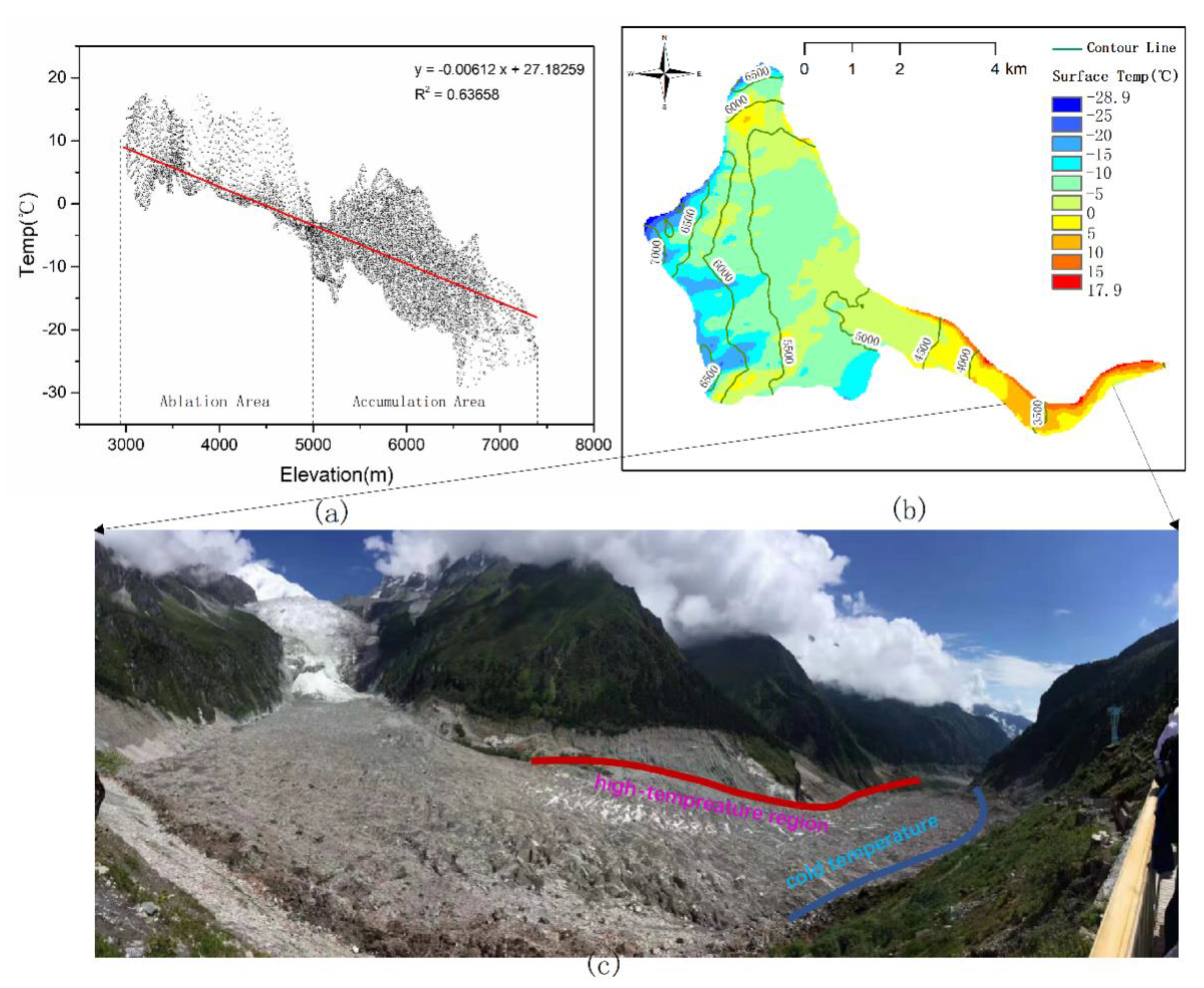
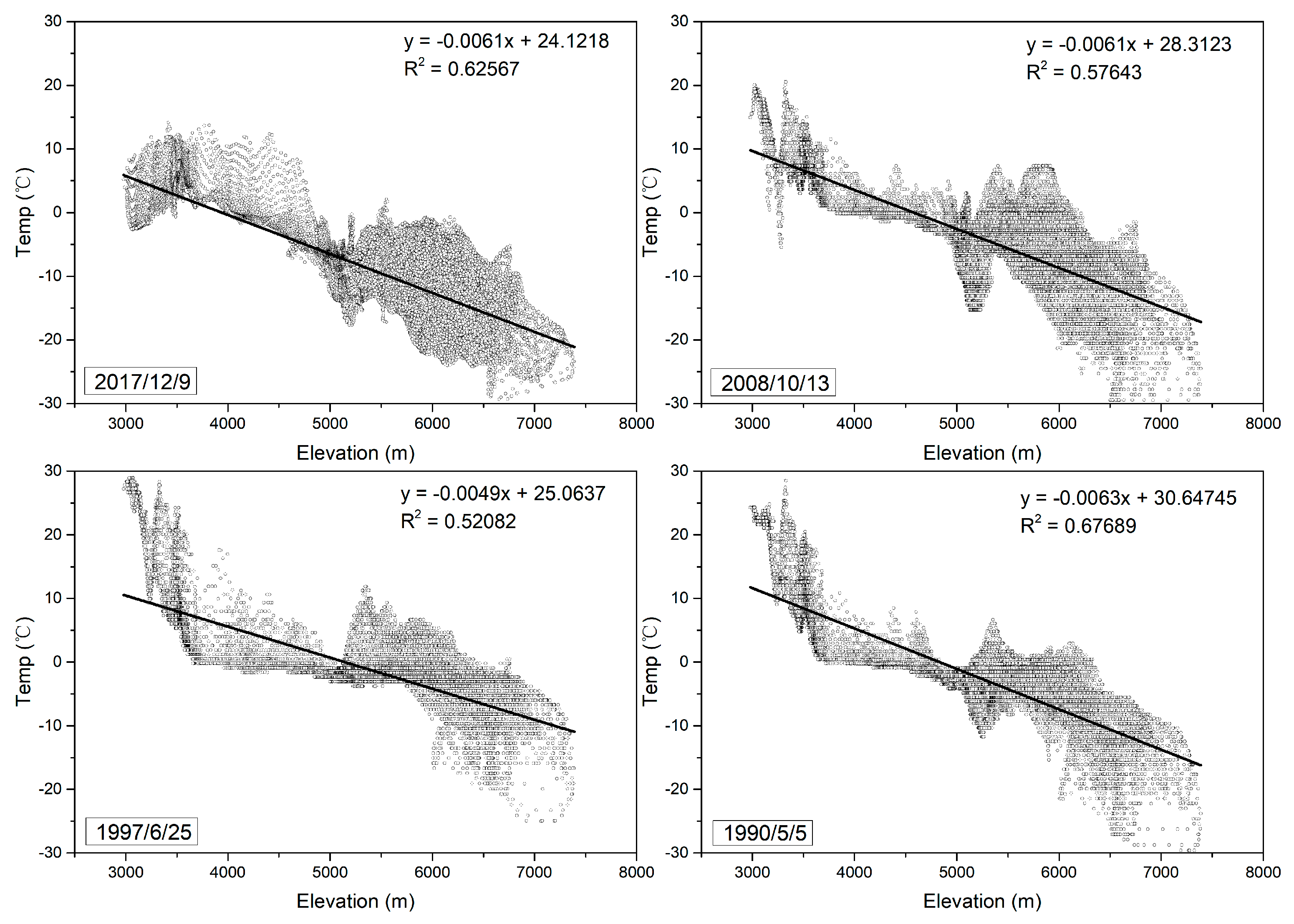
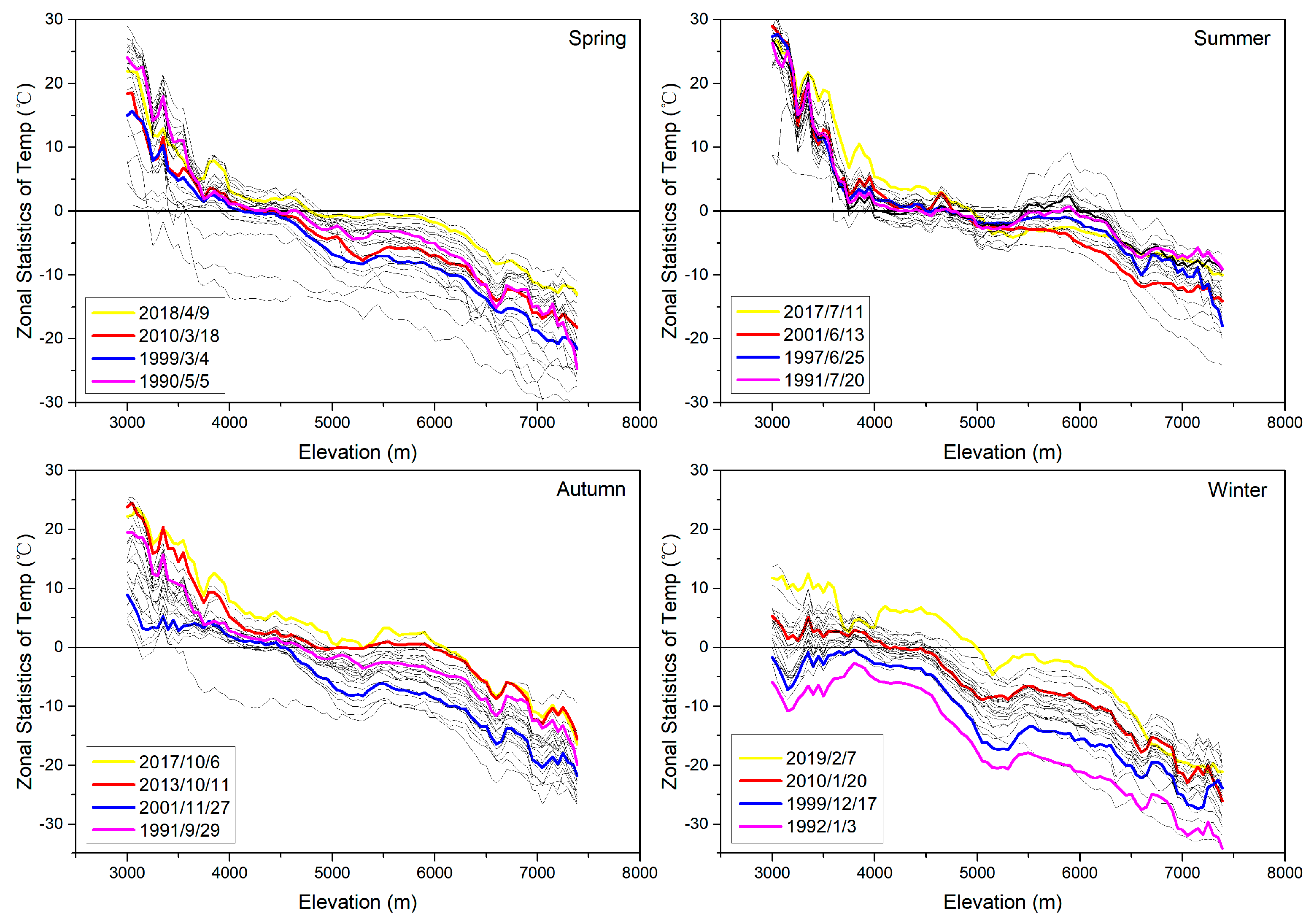
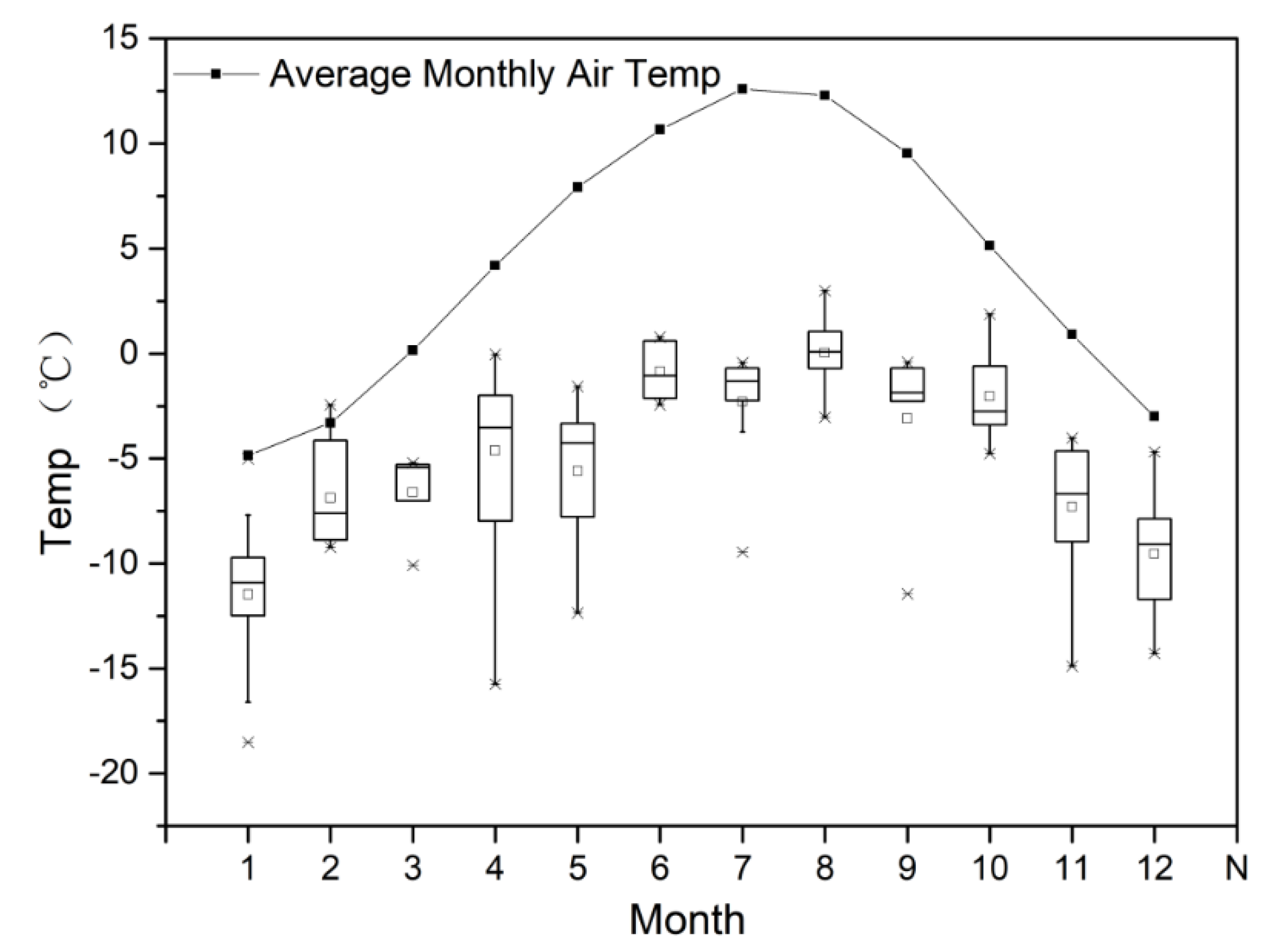

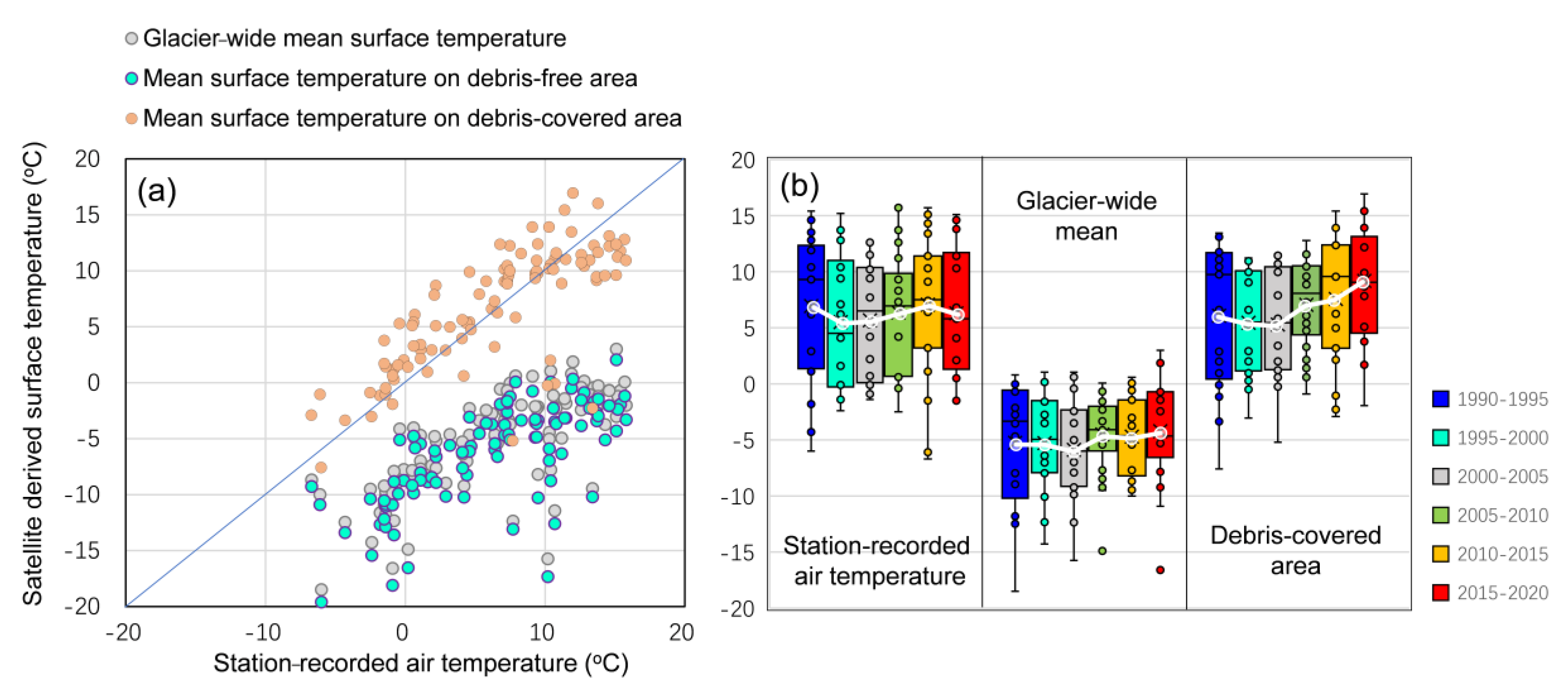


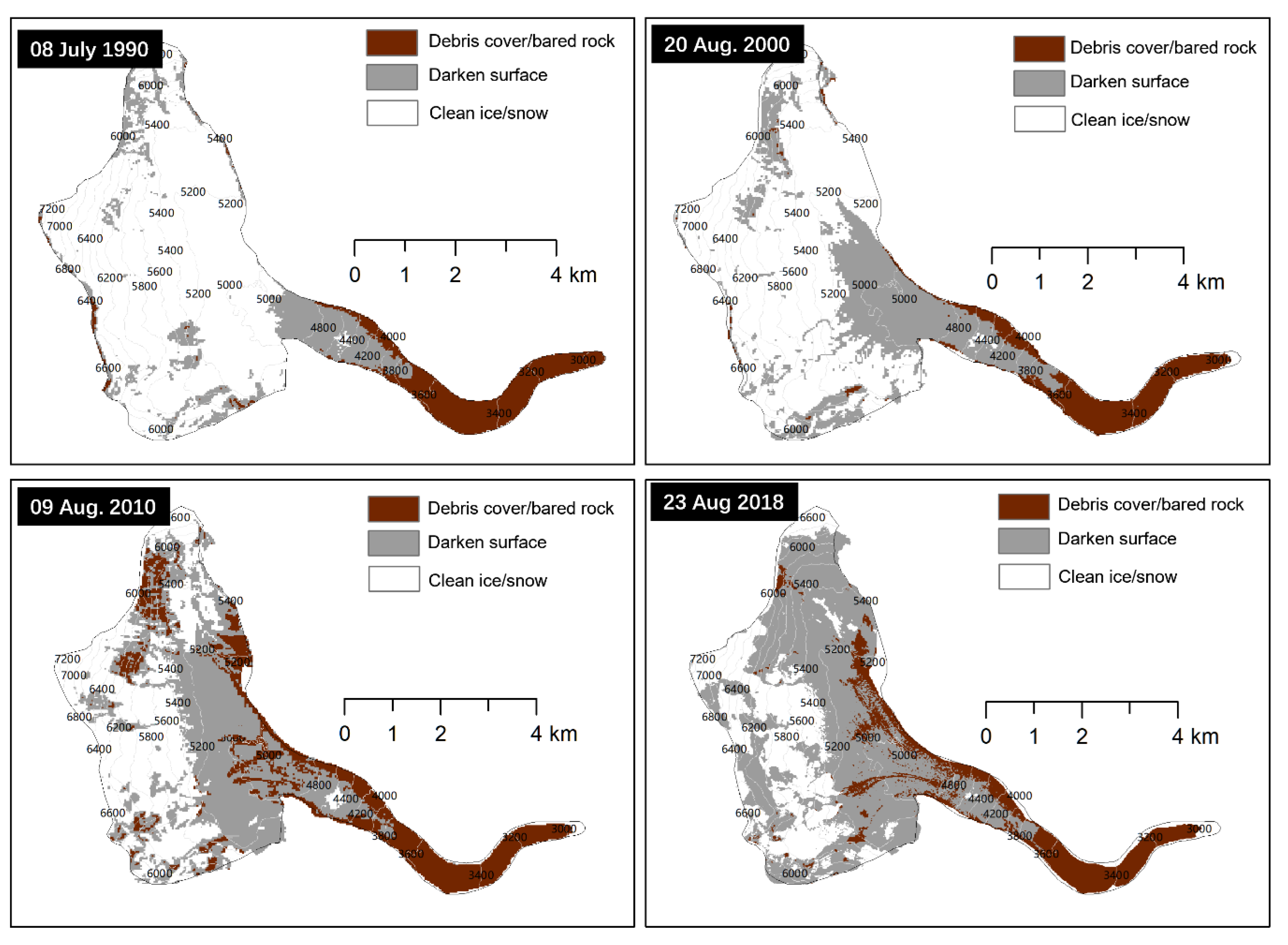
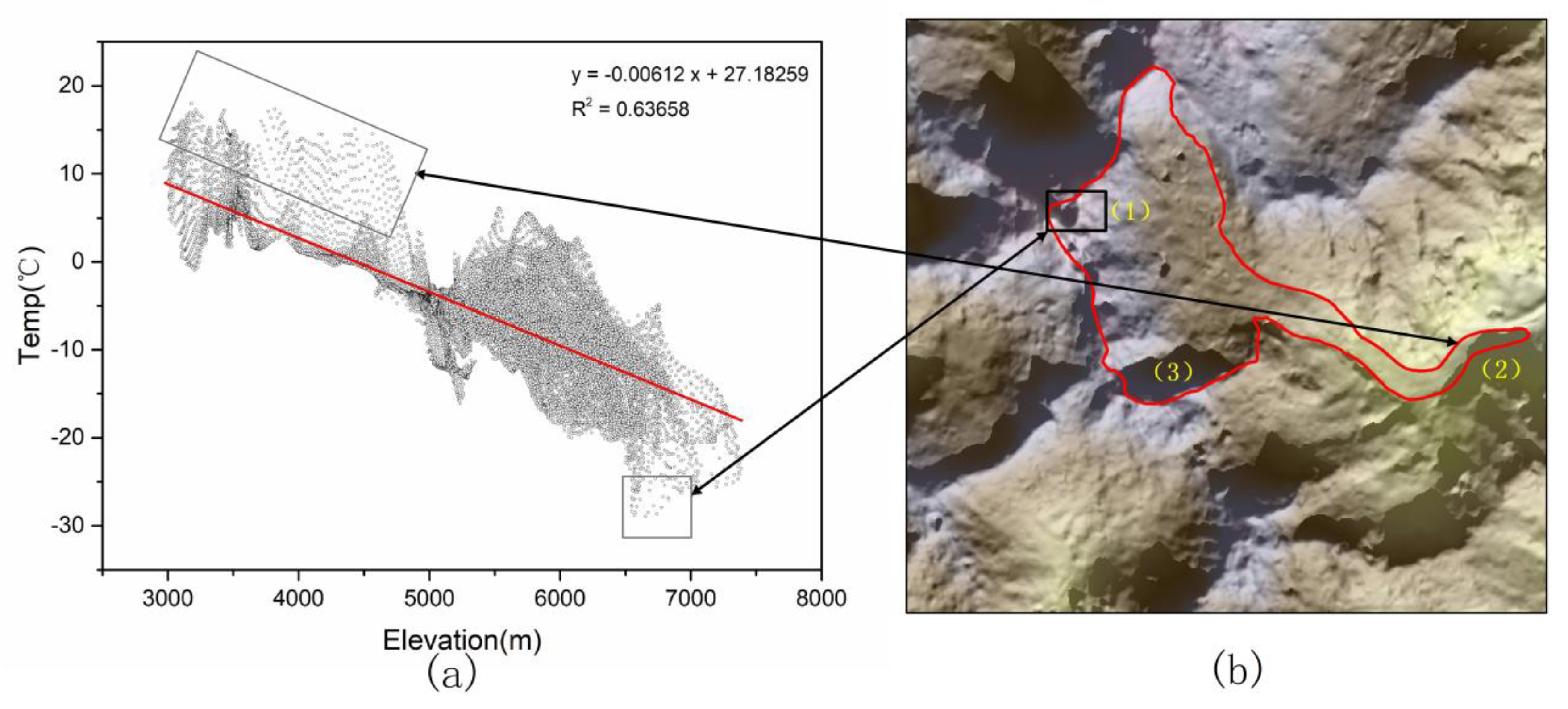
| i | ai | bi |
|---|---|---|
| 6 | −60.3263 | 0.43436 |
| 10 | −55.4276 | 0.4086 |
| Qmax | Lmin6 (m W cm−2 sr−1 μm−1) | Lmax6 (m W cm−2 sr−1 μm−1) | K1 (m W cm−2 sr−1 μm−1) | K2 (K) |
|---|---|---|---|---|
| 255 | 0.1238 | 1.56 | 60.776 | 1260.56 |
| M10 | A10 | K1 (W m−2 sr−1μm−1) | K2 (K) |
|---|---|---|---|
| 0.0003342 | 0.1 | 774.89 | 1321.08 |
| Atmosphere | Linear Relation Equation |
|---|---|
| Mid-latitude summer | Ta = 16.0110 + 0.92621To |
| Mid-latitude winter | Ta = 19.2704 + 0.91118To |
| Profile | w (g cm−2) | Linear Relation Equation | R2 | SEE |
|---|---|---|---|---|
| High air temperature | 0.4–1.6 | τ6 = 0.974290 – 0.08007w | 0.99611 | 0.002368 |
| 1.6–3.0 | τ6 = 1.031412 – 0.11536w | 0.99827 | 0.002539 | |
| Low air temperature | 0.4–1.6 | τ6 = 0.982007 – 0.09611w | 0.99463 | 0.003340 |
| 1.6–3.0 | τ6 = 1.053710 – 0.14142w | 0.99899 | 0.002375 | |
| Mid-latitude summer | 0.2–1.6 | τ10 = 0.9184 – 0.0725w | 0.983 | 0.0043 |
| 1.6–4.4 | τ10 = 1.0163 – 0.1330w | 0.999 | 0.0033 | |
| 4.4–5.4 | τ10 = 0.7029 – 0.0620w | 0.966 | 0.0081 | |
| Mid-latitude winter | 0.2–1.4 | τ10 = 0.9228 – 0.0735w | 0.998 | 0.0033 |
| Date | Sensor Types | Algorithm | Max Bias (°C) | Average Bias (°C) | Average Root Mean Square Error (°C) | Number of Samples |
|---|---|---|---|---|---|---|
| 2017/12/9 | TIRS | JM_SC | 1.7 | 0.7 | 0.8 | 27,275 |
| 2013/10/11 | TIRS | JM_SC | 1.8 | 0.8 | 0.8 | 27,275 |
| 2006/8/30 | TM | JM_SC | 0.8 | 0.6 | 0.6 | 27,275 |
| 2000/5/9 | TM | JM_SC | 0.8 | 0.7 | 0.7 | 27,275 |
| Mean | - | - | 1.3 | 0.7 | 0.7 | - |
| 2017/12/9 | TIRS | RTE | 4.0 | 1.4 | 1.5 | 27,275 |
| 2013/10/11 | TIRS | RTE | 5.3 | 2.8 | 2.9 | 27,275 |
| 2006/8/30 | TM | RTE | 2.1 | 1.6 | 1.6 | 27,275 |
| 2000/5/9 | TM | RTE | 1.6 | 1.1 | 1.1 | 27,275 |
| Mean | - | - | 3.3 | 1.7 | 1.7 | - |
© 2020 by the authors. Licensee MDPI, Basel, Switzerland. This article is an open access article distributed under the terms and conditions of the Creative Commons Attribution (CC BY) license (http://creativecommons.org/licenses/by/4.0/).
Share and Cite
Liao, H.; Liu, Q.; Zhong, Y.; Lu, X. Landsat-Based Estimation of the Glacier Surface Temperature of Hailuogou Glacier, Southeastern Tibetan Plateau, Between 1990 and 2018. Remote Sens. 2020, 12, 2105. https://doi.org/10.3390/rs12132105
Liao H, Liu Q, Zhong Y, Lu X. Landsat-Based Estimation of the Glacier Surface Temperature of Hailuogou Glacier, Southeastern Tibetan Plateau, Between 1990 and 2018. Remote Sensing. 2020; 12(13):2105. https://doi.org/10.3390/rs12132105
Chicago/Turabian StyleLiao, Haijun, Qiao Liu, Yan Zhong, and Xuyang Lu. 2020. "Landsat-Based Estimation of the Glacier Surface Temperature of Hailuogou Glacier, Southeastern Tibetan Plateau, Between 1990 and 2018" Remote Sensing 12, no. 13: 2105. https://doi.org/10.3390/rs12132105
APA StyleLiao, H., Liu, Q., Zhong, Y., & Lu, X. (2020). Landsat-Based Estimation of the Glacier Surface Temperature of Hailuogou Glacier, Southeastern Tibetan Plateau, Between 1990 and 2018. Remote Sensing, 12(13), 2105. https://doi.org/10.3390/rs12132105




